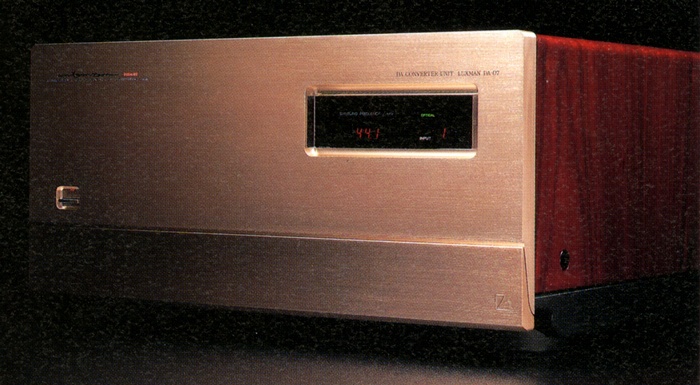
LUXMAN DA-07
¥ 800,000 (released in August 1988)
Commentary
D/A converter using F / E / DAC with emphasis on pulse reproducibility.
F ・ E ・ DAC is adopted for D/A conversion part of DA-07.
This DAC was developed based on a new theory, the Full Embassy Theory, invented by the University of Tsukuba. The structure emphasizes the reproducibility of pulse components (impulse response) beyond the reproducibility of continuous sine waves.
The F ・ E ・ DAC is fundamentally different from the conventional D/A converter in which the digital code is converted into a step-like form before analog conversion. The digital code is directly connected by a curve using a new interpolation function for analog reproduction. This realizes an extremely natural waveform natural waveform and approaches the waveform of an analog signal of music. Moreover, the F ・ E ・ DAC has excellent impulse response and faithfully responds to instantaneous pulse input without generating excessive vibration. Therefore, ideal reproducibility of step response, which was impossible with analog disks and tape decks until now, is realized.
The F ・ E ・ DAC is a waveform reproduction method in which digital codes are directly connected by a curve without changing them in a stepwise manner. Therefore, in principle, it eliminates the necessary evils such as digital filters that generate waveform vibration and analog filters that inevitably generate phase shifts.
The analog circuit uses a pure A-class service machine that supplies a constant bias current up to the maximum output.
The quality of DAC is fully utilized by the pure A-class system and low-impedance transmission analog circuit that LAX has consistently adopted.
The input jacks are equipped with coaxial input Route 3 and optical input Route 3.
Two high-speed standard type optical input terminals are installed, and the other one is equipped with an ultra-high-speed optical terminal unique to LUX with a transmission rate several tens of times higher than that of the conventional one.
In addition, two digital output terminals (standard type optical and coaxial) are installed as digital outputs for recording.
In addition to the canon connector for balanced outputs, the analog outputs are equipped with a total Route 3 output of one direct / variable coaxial outputs each.
The chassis consists of two stages, and the analog and digital sections are completely separated. Each block is separated into a total of 10 rooms for complete shielding.
The entire chassis is plated with copper to eliminate mutual interference. In addition, the front panel made of 18 mm thick extruded material and special FRP bottom chassis with high rigidity and large mass are made to eliminate resonance of the entire structure.
The power supply unit is equipped with two transformers that are independent of analog / digital. In addition, the power supply configuration is completely independent of L/R for both analog and digital. In addition, the use of a rectifier circuit and an 11-division independent regulator eliminates interference between analog / digital, channels, and blocks.
We use carefully selected parts such as pure focus condenser with special coating resistance of gold plated cap and sound quality countermeasure, PC-OCC wire material for all wiring materials, glass epoxy board with 70 micron thickness OFC pattern, etc.
Multi-multi-processor capability and supports sampling frequencies of 32 khz, 44.1 khz and 48 khz.
It has a simple design with only a power switch and an output digital display when the sealing panel is closed. In addition, an oil dump system is used for the sealing panel, allowing smooth opening and closing.
Inside the ceiling panel is equipped with an output level volume, a dimmer switch for adjusting the display brightness, and an input selector.
Model Rating
| Type | D/A converter |
| D/A converter | F / E / DAC, 16 bit, without LPF |
| Digital input terminal | Coaxial1, 2, 3 : 0.5Vp-p/75 Ω Optical1 : LUX dedicated type, 125Mb/s Optical2, 3 : EIAJ standard type, 6Mb/s |
| Digital recording terminal | Coaxial : 0.5Vp-p/75 Ω Optical : EIAJ standard type, 6Mb/s |
| Analog output terminal | Coaxial Fixed : 2V/47 Ω Variable : 2V/100 Ω Balanced Fixed : 4V/94 ohm |
| Sampling frequency | 32 kHz, 44.1 kHz, 48 kHz (automatic switching) |
| Frequency characteristic | 4 Hz ~ 20 kHz (at 44.1 kHz input) |
| Total harmonic distortion factor | 0.008%(EIAJ) |
| Impulse distortion factor | Approx. 0.4% (Conventional DA converter based on Shannon's theorem : approx. 26%) * Impulse distortion rate = Vibration peak value / Sampling peak value |
| Signal-to-noise ratio | 96 dB or more (EIAJ) |
| Dynamic range | 96dB(EIAJ) |
| Channel separation | 115 dB or more (EIAJ) |
| Attachment | Line phase sensor |
| Pwer | 100 VAC, 50Hz/60Hz |
| Power consumption | 43W |
| Maximum external dimensions | Width 438x Height 220x Depth 474 mm |
| Weight | 27kg |
| Sold Separately | LUX Type Optical Cable PG-5 (¥ 50,000) |
.jpg)
.jpg)
.jpg)
.jpg)
.jpg)